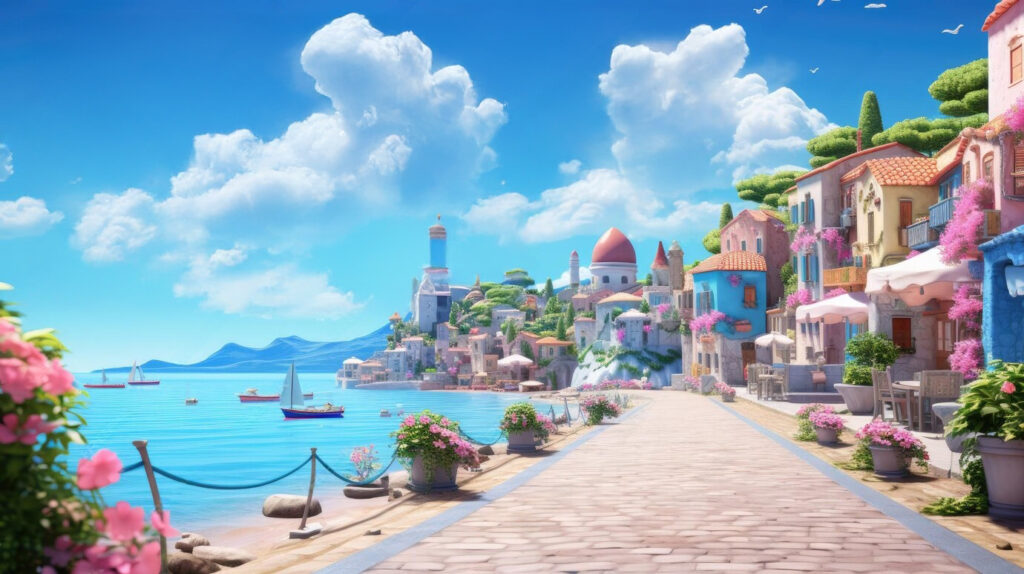When it comes to visually stunning and emotionally captivating art, Studio Ghibli stands in a league of its own. The Japanese animation powerhouse, co-founded by the legendary Hayao Miyazaki and Isao Takahata, has set a gold standard for breathtaking landscapes, intricate character designs, and emotionally resonant storytelling. But beyond their success in the world of animation, Ghibli’s art style offers a wealth of inspiration for graphic designers looking to add more depth, emotion, and enchantment to their work.
If you’re a designer, artist, or creative professional looking for a fresh perspective, Ghibli art provides a unique approach that can transform your work. In this article, we’ll explore what makes Ghibli art so special and how you can apply its techniques to improve your graphic designs.

What is Ghibli Art?
Ghibli art refers to the distinct artistic style used in Studio Ghibli films. It is characterized by:
- Dreamlike Backgrounds: Lush, painterly environments with a sense of realism and depth, often inspired by nature.
- Expressive Characters: Ghibli’s characters are designed with simple yet deeply expressive facial features, allowing emotions to shine through.
- Attention to Detail: Every frame in a Ghibli film is meticulously crafted, from the smallest objects to grand landscapes.
- Soft and Natural Colors: A gentle color palette, often featuring soft pastels and warm earthy tones, makes the art feel inviting and organic.
- A Sense of Wonder: Ghibli art often evokes nostalgia, mystery, and an appreciation for the beauty of the world.

How to Use Ghibli Art to Enhance Your Graphic Design
1. Incorporate Hand-Painted Aesthetics
Ghibli backgrounds often have a hand-painted, watercolor feel that adds warmth and authenticity. As a graphic designer, you can replicate this effect by using digital painting techniques or watercolor-style brushes in software like Photoshop or Procreate. Avoid overly sharp or artificial edges—opt instead for soft, blended strokes to create an organic feel.
2. Create Immersive Backgrounds
One of the standout features of Ghibli films is the way their backgrounds make you feel like you could step right into the world. If you’re designing a website, poster, or social media graphic, consider using rich, immersive backgrounds to set the tone. Adding depth through atmospheric perspective—where distant objects appear softer and lighter—can make your designs feel more dynamic and alive.

3. Use Ghibli’s Color Theory
Colors play a crucial role in the emotional impact of Ghibli films. Study the palettes used in movies like Spirited Away or My Neighbor Totoro. They often combine:
- Earthy greens and browns for warmth and nostalgia.
- Soft blues and purples to create a calming or dreamy effect.
- Bright reds and oranges for moments of energy and excitement.
Try using similar color combinations in your branding, illustrations, or UI/UX designs to evoke emotions subtly.
4. Pay Attention to Small Details
Ghibli’s meticulous attention to detail adds depth and believability to its art. Whether it’s the rust on an old bike or the way leaves rustle in the wind, these small elements make the world feel real. In graphic design, adding subtle textures, intricate linework, or natural imperfections can make your work feel more handcrafted and unique.
5. Emphasize Emotion in Characters
Ghibli characters are known for their expressive faces and natural movement. If you’re designing character-based graphics (such as mascots, avatars, or branding illustrations), focus on simple yet effective ways to convey emotion. Exaggerating expressions slightly and ensuring a character’s posture aligns with their emotions can make them feel more relatable.

6. Use Nature as a Source of Inspiration
Nature is a recurring theme in Ghibli films, often depicted with breathtaking beauty. Whether it’s a meadow bathed in sunlight or a quiet, misty forest, nature in Ghibli art often feels alive. Try incorporating more organic elements—like trees, water, or flowers—into your designs. Even abstract works can benefit from the calming and natural flow inspired by the outdoors.
7. Balance Simplicity and Complexity
While Ghibli art is highly detailed, it never feels overwhelming. It strikes a perfect balance between simplicity and complexity. As a designer, this principle can guide you in maintaining clarity while still adding depth. Avoid cluttering your work; instead, focus on composition and guiding the viewer’s eye naturally through the design.
8. Tell a Story Through Your Design
Every Ghibli film tells a compelling story, and their art supports that narrative beautifully. In graphic design, storytelling is just as important. Whether you’re creating an advertisement, packaging, or a social media post, think about how the elements of your design guide the viewer through a visual journey. Use color, composition, and details to create a mood or emotion that tells a story.
Studio Ghibli’s art is more than just visually stunning—it’s a masterclass in emotion, storytelling, and artistic craftsmanship. By incorporating Ghibli-inspired techniques into your graphic design projects, you can create works that feel rich, immersive, and emotionally resonant.
Whether it’s through hand-painted aesthetics, thoughtful color choices, or attention to detail, Ghibli art offers a world of inspiration that can take your designs to the next level. So next time you sit down to design, channel a bit of Ghibli magic, and see where it takes you!
Do you have a favorite Ghibli movie that inspires your work? Let us know in the comments below!




